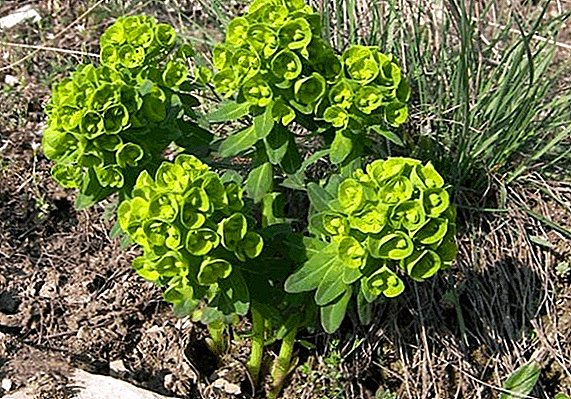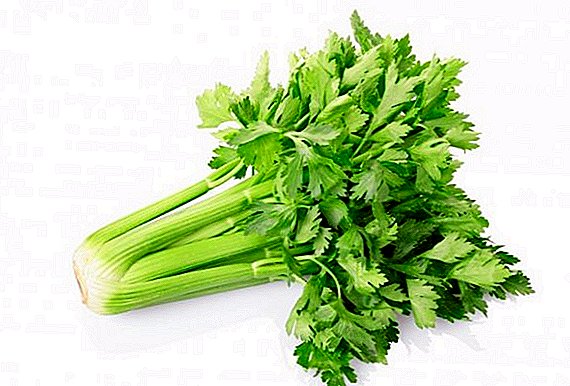 Celery - biennial plant of umbrella class. It is often used in the preparation of a variety of dishes: first, second, desserts. Celery can be grown on your land, as the plant is accustomed to any climate, frost.
Celery - biennial plant of umbrella class. It is often used in the preparation of a variety of dishes: first, second, desserts. Celery can be grown on your land, as the plant is accustomed to any climate, frost.
When to harvest for storage
Celery is harvested in late autumn, it easily tolerates frost, so you can not rush to harvest. Celery root is harvested using a fork, in order not to damage the roots. Plant break in and poddergivayut for tops. Most often, the foliage is cut under the roots and left on the site as fertilizer for the next season. Celery celery is harvested in mid-autumn, when it contains the most juice and nutrients.
Did you know? In the two most famous works of Homer "Iliad" and "Odyssey" the author mentions celery. In the Iliad, myrmidon horses grazed in meadows of cornflowers and celery, and in Odyssey wild celery grew around Calypso's cave.
Celery harvesting for the winter
The stalks and roots of celery are rich in useful microelements, in winter it is more than a useful product. Celery shelf life when properly stored is one year.
How to save celery root
If you have a cellar or basement, celery roots can be stored in boxes with peat or wet sand. At home, the roots are washed from the ground, dried and packed in bags or food film. You can store the prepared product in the refrigerator in the vegetable compartment.
Important! It is undesirable to store celery root in the freezer, it loses its properties, such a product will be appropriate only after heat treatment.
How to save celery leaves
 To store the stalked celery, cut stalks are washed, sorted and dried from moisture. Then it can be folded in a bag and stored in a refrigerator on a shelf. For better storage in the package you need to make a couple of holes for ventilation. Petioles can be stored until the beginning of spring at a temperature not higher than one degree of heat. If it is possible to store in the basement, scoop out along with the root and store it in a box with wet sand.
To store the stalked celery, cut stalks are washed, sorted and dried from moisture. Then it can be folded in a bag and stored in a refrigerator on a shelf. For better storage in the package you need to make a couple of holes for ventilation. Petioles can be stored until the beginning of spring at a temperature not higher than one degree of heat. If it is possible to store in the basement, scoop out along with the root and store it in a box with wet sand.
How to dry celery
You can make for the winter harvesting of celery leaf. Drying at the same time is considered the easiest method. It is easier to dry with bunches, not under the direct sun, in a cool room. Can be laid out on a flat surface and dried, covered with a sheet of parchment. The process lasts about a month. Finished products can be crushed into powder and used as a spice, can be a little bigger. In any case, such products should be stored in a glass container with a tight-fitting lid. It is advisable to put in a dark and dry place.
In the same way, you can dry the celery root. Cut it into convenient forms (cubes, ringlets, stripes), dry well. Store in a glass container in a dark, dry room. Such blanks are convenient to use in the first and second dishes, in sauces.
Celery Freeze for Winter
 The easiest way to keep celery fresh for the winter without having a cellar is to freeze. Celery leaves to sort and wash, dry on a paper towel. Grind the leaves with a sharp knife, fill the ice cells with greens, add a little pure water - and in the freezer. When the cubes are frozen, put them in a bag and leave in the freezer.
The easiest way to keep celery fresh for the winter without having a cellar is to freeze. Celery leaves to sort and wash, dry on a paper towel. Grind the leaves with a sharp knife, fill the ice cells with greens, add a little pure water - and in the freezer. When the cubes are frozen, put them in a bag and leave in the freezer.
How to freeze stalked celery - as well as leaf celery. Prepared petioles can be stored whole in a bag, can be crushed and folded in a plastic container, sending it to the freezer.
Attention! Celery is a very useful product, but there are limitations. Too frequent use is undesirable for pregnant women, the active substances of the plant increase the tone of the uterus, which can trigger an abortion.
Salted celery
Salted celery can be stored and used for a long time in almost all dishes. For salting need a kilogram of washed and crushed leaves, 250 grams of salt. The ingredients are mixed and placed in jars in such a way as to leave little room for juice. As soon as the juice comes through, the banks are rolled up and stored in a pantry or cellar.
Interesting! Celery was brought to the USA thanks to George Taylor, a Scot brought him in 1865 to the state of Michigan, the city of Kalamazoo. Vegetable soon became the hallmark of this city - there is also a museum of celery.
Marinating celery for winter
 Marinated celery can be used as an independent snack and as an additive in hot dishes.
Marinated celery can be used as an independent snack and as an additive in hot dishes.
For cooking will need: 1 kg of celery root, 1 liter of water, 1 tbsp. l salt, 3 grams of citric acid. For the marinade: 800 ml of water, 200 ml of vinegar, 4 peas of pepper and cloves.
The roots are crumbled into cubes or half rings, blanched in salted water for a few minutes. Then removed from the water and put in jars. While the celery cools, cook marinade. Hot marinade pour the contents of the cans, pasteurized for 20 minutes, roll up the lids.
Celery leaf also has its recipe for marinating for the winter.
Per liter jar will need: garlic 4 cloves, a pair of laurel leaves. For the marinade: 700 ml of water, 150 ml of vinegar, 70 grams salt, 100 grams sugar.
Garlic and laurel are put on the bottom, densely chopped celery leaves are placed on top, and they are poured with hot marinade. Banks are sterilized with the contents of 20 minutes, covered with lids.
Celery Canning Recipes
Recipe number 1
- celery root - 100 grams
- celery greens - 100 grams
- parsley - 100 grams
- leek - 100 grams (white stem)
- salt - 100 grams
 Celery roots cut into thin strips, celery greens and parsley - large pieces 1.5 cm long, leeks - rings. Ingredients folded in a bowl, add salt, mix. Then tightly put in jars, leave to let the juice. Cover with tight lids and store in a cool place.
Celery roots cut into thin strips, celery greens and parsley - large pieces 1.5 cm long, leeks - rings. Ingredients folded in a bowl, add salt, mix. Then tightly put in jars, leave to let the juice. Cover with tight lids and store in a cool place.Recipe number 2. Celery stalk prepared in marinade for the winter.
- celery stalks to taste
- garlic (teeth) -2-3 pieces
- sugar - 3 tbsp. l
- salt - 3 tbsp. l
- vinegar 9% to taste
- laurel - 1-2 leaves
This article marks the simplest and most interesting recipes. Winter does not spoil us with vitamins, so homemade preparations are always needed for dietary diversity and as an alternative to fresh vegetables and fruits.












